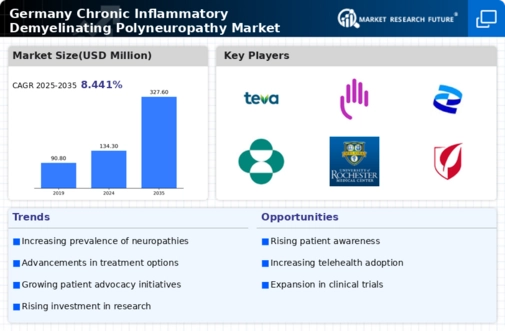Government Initiatives and Funding
Government initiatives and funding play a crucial role in shaping the chronic inflammatory-demyelinating-polyneuropathy market. In Germany, various health policies aim to improve the quality of care for patients with neurological disorders. The government has allocated substantial resources to research and development in the field of neurology, which may lead to breakthroughs in CIDP treatment. Furthermore, public health campaigns aimed at increasing awareness of CIDP among both healthcare professionals and the general population are being implemented. These initiatives could potentially enhance early diagnosis and treatment, thereby improving patient outcomes. The financial support for clinical trials and research projects is also expected to foster innovation in the market, ultimately benefiting patients and healthcare providers alike.
Advancements in Treatment Modalities
Innovations in treatment modalities are significantly impacting the chronic inflammatory-demyelinating-polyneuropathy market. The introduction of novel therapies, including monoclonal antibodies and immunosuppressive agents, has transformed the management of CIDP. For instance, therapies such as eculizumab and rituximab have shown promising results in clinical trials, leading to their increased adoption in clinical practice. The German healthcare system is increasingly integrating these advanced treatment options, which may enhance patient outcomes and satisfaction. Additionally, the development of personalized medicine approaches tailored to individual patient profiles could further optimize treatment efficacy. As a result, the market is likely to witness a shift towards more effective and targeted therapies, which could drive growth in the coming years.
Technological Integration in Healthcare
Technological integration in healthcare is emerging as a key driver for the chronic inflammatory-demyelinating-polyneuropathy market. The adoption of digital health solutions, such as electronic health records and telehealth platforms, is transforming the way healthcare providers manage CIDP. In Germany, the implementation of these technologies facilitates better communication between patients and healthcare professionals, enabling timely interventions and follow-ups. Additionally, the use of data analytics in monitoring patient progress and treatment efficacy is becoming increasingly prevalent. This technological advancement may lead to more informed decision-making and personalized treatment approaches. As healthcare systems continue to evolve, the integration of technology is likely to enhance the overall management of CIDP, thereby positively impacting the market.
Increasing Prevalence of Neurological Disorders
The chronic inflammatory-demyelinating-polyneuropathy market is experiencing growth due to the rising prevalence of neurological disorders in Germany. Recent studies indicate that the incidence of chronic inflammatory-demyelinating-polyneuropathy (CIDP) is approximately 1.5 to 2 cases per 100,000 individuals annually. This increasing prevalence necessitates enhanced healthcare services and treatment options, thereby driving market demand. Furthermore, as the population ages, the likelihood of developing neurological conditions increases, which could further elevate the number of CIDP cases. Consequently, healthcare providers are focusing on improving diagnostic capabilities and treatment protocols, which may lead to a more robust market landscape. The growing awareness among healthcare professionals regarding CIDP is also contributing to earlier diagnosis and intervention, which is crucial for effective management of the condition.
Rising Demand for Specialized Healthcare Services
The chronic inflammatory-demyelinating-polyneuropathy market is experiencing a rising demand for specialized healthcare services. As awareness of CIDP grows, patients are increasingly seeking expert care from neurologists and specialized clinics. This trend is reflected in the establishment of dedicated neurology centers across Germany, which focus on providing comprehensive care for patients with CIDP and other neurological disorders. The availability of multidisciplinary teams, including physiotherapists and occupational therapists, enhances the overall management of the condition. Moreover, the emphasis on patient-centered care is likely to drive the demand for tailored treatment plans and follow-up services. This shift towards specialization may lead to improved patient outcomes and satisfaction, thereby contributing to the growth of the market.

























Leave a Comment